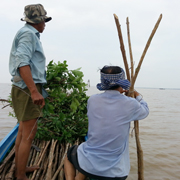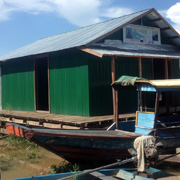
|
A mid-term review was recently completed of the EU funded and IUCN and FACT implemented project Strengthening capacity of fishing communities in the Tonle Sap to manage their natural resources sustainably, which has helped establish and test the value of fish conservation areas (FCAs) in the Tonle Sap.
|
| The review found that the community fisheries committees, which manage the FCAs, emphasized repeatedly that boundary demarcation and signage are vital for legitimizing the FCA, and that fish attraction devices (FADs) made up of dead trees sunk in the FCA are win-win interventions because they provide fish habitat and by snagging nets they deter fishing inside the FCA. |  |
|
In Kampong Phluk Commune near Siem Reap, one of the three sites where the project intervenes, six hardwood posts were installed in May 2014 around the 200-hectare FCA known as Chroy Chhnang. The posts are buried 1.5 meters in the lake bed and can resist the strong wind and wave action in the open lake. They should last 10-20 years. Wood was preferred to concrete because it’s much cheaper: one concrete platform costs the same as the six wooden posts. But the committee was concerned that the six posts, each 1,000 meters apart, did not mark the FCA boundary clearly enough, thereby complicating protection efforts. They therefore paid for and installed another 200 posts, each made up of three wooden poles. The demarcation work was completed on February 22. It represents not only a major financial and in-kind contribution to the FCA but reflects growing support for the concept of a strictly protected FCA to restore fish populations and sustain local livelihoods. For the sketch map of demarcation poles around fish conservation area, please see link. During a visit to the FCA by staff and students from Paññasastra University and officials from the US Embassy in Phnom Penh on April 22, the commitee members and local authorities installed 200 branches in the FCA to serve as FADs. The wood had a cash value of US$1,500. This kind of initiative reflects the growing confidence and capacity of the commitee, which was elected in 2013 with project support. |















Leave a Reply